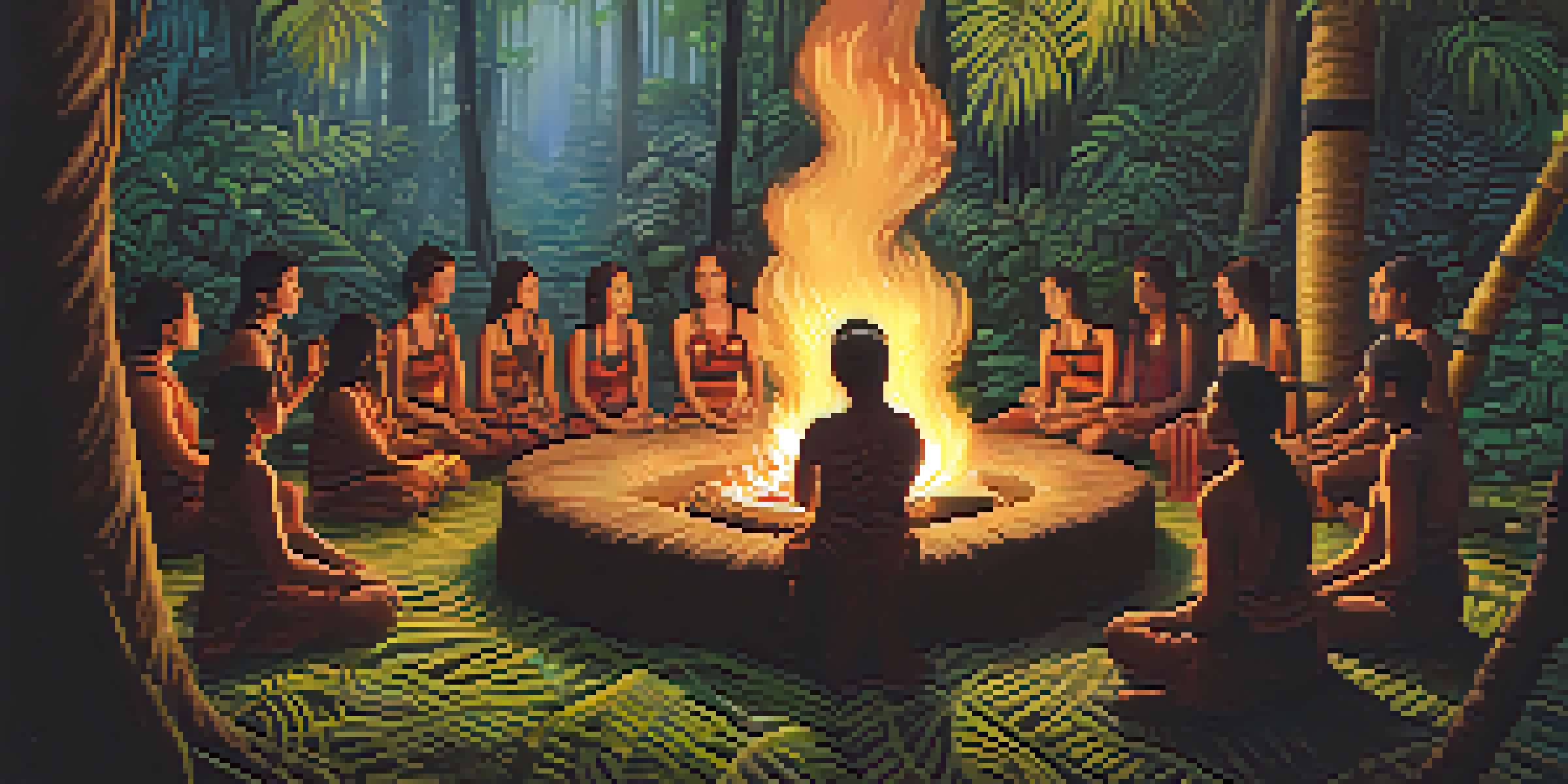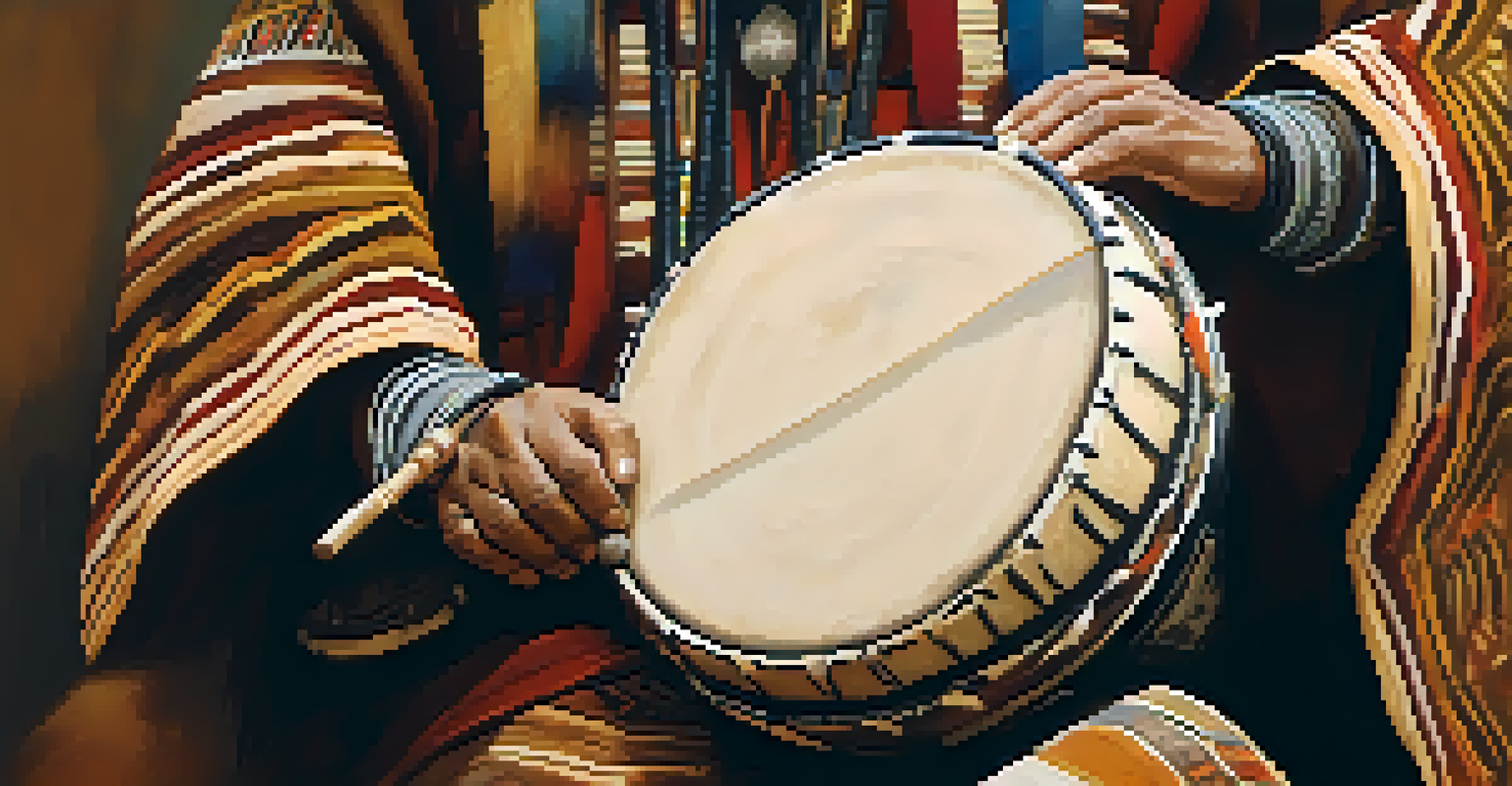Soundscapes: The Environment of Music in Ayahuasca Ceremonies

Understanding Ayahuasca and Its Cultural Significance
Ayahuasca is a powerful plant medicine traditionally used in South American shamanic practices. It combines the Banisteriopsis caapi vine and the Psychotria viridis leaf, creating a brew that induces altered states of consciousness. This experience is often guided by a shaman, who plays a crucial role in facilitating the ceremony and ensuring safety.
Music can change the world because it can change people.
The cultural significance of Ayahuasca extends beyond its psychoactive properties; it's deeply rooted in the spiritual and social fabric of indigenous communities. These ceremonies aim to promote healing, self-discovery, and connection to the divine. Understanding this context enhances our appreciation of the role that music plays within these rituals.
Incorporating traditional beliefs and practices, Ayahuasca ceremonies highlight the importance of community and shared experiences. Participants often enter these gatherings seeking clarity, guidance, or healing, setting the stage for the transformative power of sound and music.
The Role of Sound in Ayahuasca Ceremonies
Sound is an integral part of Ayahuasca ceremonies, serving both as a guide and a catalyst for emotional release. The shaman typically uses a variety of instruments, such as drums, rattles, and flutes, to create a sonic environment that supports the journey. This soundscape can influence the emotional tone of the ceremony, providing comfort and encouragement.

As participants enter altered states, the music can evoke memories or feelings, prompting introspection and healing. The vibrations from the instruments resonate with individuals on a deep level, often unlocking emotions that may have been buried. The synergy of sound and experience is what makes these ceremonies so profound.
Ayahuasca's Cultural Importance
Ayahuasca ceremonies are deeply rooted in indigenous traditions, focusing on healing, self-discovery, and spiritual connection.
Moreover, the shaman’s voice often becomes a central element, weaving traditional songs known as icaros into the fabric of the ceremony. These sacred songs are believed to carry healing energy and can guide participants toward revelations or insights.
Creating a Supportive Soundscape
A supportive soundscape is one that resonates with the participants’ emotional states, providing comfort and direction during their journey. The shaman consciously selects music that aligns with the energy of the group, ensuring a harmonious atmosphere. This careful curation helps participants feel safe and open to the experience.
The power of sound is the power of creation itself.
Different instruments evoke different feelings; for instance, drums might create a sense of grounding, while flutes can inspire a feeling of transcendence. The dynamics of the soundscape can shift throughout the ceremony, reflecting the evolving emotional landscape of the participants. This responsiveness creates a fluid experience that can be both cathartic and enlightening.
Additionally, silence is often interspersed within the soundscape, allowing participants to reflect and absorb their experiences. These moments can feel profound, as they provide space for contemplation and integration of the journey.
The Impact of Music on Emotional Healing
Music has a powerful effect on emotions, and in the context of Ayahuasca ceremonies, this effect can be magnified. The soundscapes created during these rituals can help participants confront difficult emotions, leading to catharsis and healing. The interplay between music and emotional release can catalyze transformative experiences, allowing individuals to process trauma.
Many participants report feeling a sense of connection to the music that goes beyond mere enjoyment; it resonates with their inner struggles and joys. The sonic elements can serve as a mirror, reflecting back the emotional states that need to be acknowledged and released. This process can be incredibly liberating.
The Healing Power of Sound
Music in Ayahuasca ceremonies acts as a catalyst for emotional release, helping participants process trauma and foster connection.
Furthermore, the communal aspect of experiencing music together fosters a sense of unity among participants. Sharing this journey through sound can strengthen bonds and create lasting connections, enhancing the overall healing experience.
The Evolution of Sound in Contemporary Ceremonies
In recent years, Ayahuasca ceremonies have attracted a diverse range of participants, leading to an evolution in the soundscapes used. While traditional elements remain vital, contemporary shamans may also incorporate modern instruments and musical genres. This blending can create a unique atmosphere that resonates with a new generation of seekers.
For instance, electronic music elements have found their way into some ceremonies, offering fresh interpretations of traditional soundscapes. This fusion allows participants to engage with the experience in a way that feels relevant to their lives, bridging the gap between ancient practices and modern sensibilities. It's a testament to the adaptability of these ceremonies.
However, it's vital to approach these changes with respect for the cultural origins of the practices. Maintaining the integrity of traditional music while exploring new avenues can enrich the experience without overshadowing the roots of the ceremony.
Personal Experiences: Testimonials from Participants
Many participants of Ayahuasca ceremonies have shared profound experiences related to the soundscapes they encountered. For instance, one individual described how the rhythm of the drums echoed their heartbeat, creating a deep sense of connection to their body and surroundings. These personal anecdotes highlight the intimate relationship between music and the journey of self-discovery.
Another participant recounted a moment when the shaman sang an icaro that seemed to illuminate a path through their emotional turmoil. The combination of the melody and the words provided clarity and comfort, guiding them through a challenging experience. Such testimonials emphasize the healing potential embedded in the sounds of the ceremony.
Evolving Soundscapes in Ceremonies
Contemporary Ayahuasca ceremonies incorporate modern instruments alongside traditional sounds, creating unique and relevant experiences for participants.
These stories serve to illustrate the transformative power of music in facilitating deep emotional work and healing. As participants reflect on their journeys, the soundscapes remain vivid memories, often regarded as catalysts for change.
Conclusion: The Transformative Power of Soundscapes
In conclusion, soundscapes play a crucial role in shaping the experiences of Ayahuasca ceremonies. They serve as guides, facilitators, and healers, enhancing the emotional and spiritual journeys of participants. The interplay between traditional music and modern influences continues to evolve, enriching the overall experience.
As we explore and appreciate these soundscapes, it's vital to remain aware of their cultural significance and the wisdom they carry. By honoring the roots of these practices, we can ensure that the transformative power of sound is preserved for future generations.

Ultimately, the environment of music in Ayahuasca ceremonies illustrates the profound impact that sound can have on our lives, echoing the sentiment that healing often comes through connection—both to ourselves and to each other.